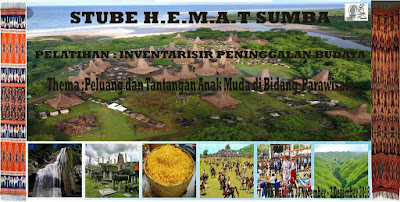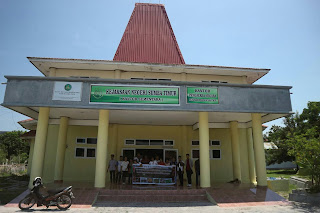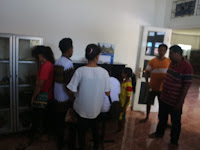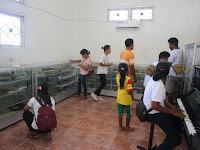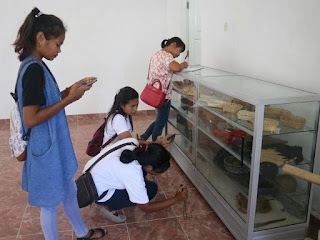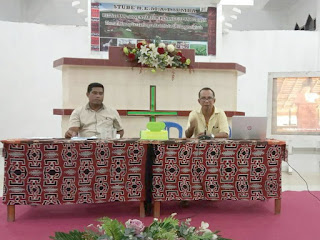Students serve their villages: Yes, we can! (2) Participants’ experiences of Village and Me program
Monday, 31 December 2018by adminstube
The progress of young people, especially students from Sumba who took part in Village and Me program from Stube-HEMAT Sumba aroused the enthusiasm of other students to participate in the next period. Their attention to their village was blooming and their fresh ideas sprung up. This has aroused optimism because more and more young people care and have spirit to build their villages which have common 'image' as lagging region. It willslowly decrease.
The second group in 2018 involved three Stube-HEMAT Sumba activist students to give their knowledge and experience during their study to their village communities spread across various regions of Sumba. They have confidence and trust that what they are doing is beneficial.
Adriana Pindi Moki, often called Ambu, conducted health education for people in her village in Waikanabu, Tabundung, East Sumba. As a nursing student at Nursing Academy of Waingapu, she was so skillful when giving counseling on family planning and health checks for couples of childbearing age and children. She also provided leaflets about maternal and child health. Those were very valuable because village people which far from city get useful reading. They responded well Ambu’s initiative to share her knowledge in health aspect and hope other students will come and share knowledge.
Trias Manu, a student from Mauhau village, East Sumba shared knowledge he learned at State Community Academy (AKN) of Waingapu majoring in Animal Feed. He practiced making liquid and solid organic fertilizers in GKS Mauhau GKS with the church members, mostly farmers. They are still using their own organic fertilizer until now. "This activities teaches me to share, not to be desperate with our limitation. Initially I was nervous and confused to start the activity, but afterfinishing all, I finally felt happy because my knowledge maybe useful," said Trias.
Makson Rangga Nduna, an activist of Stube-HEMAT Sumba,studying Development Economics in Unkriswina Sumba was interested in providing assistance to vegetable farmers around his village in Karaha, Lambanapu. He is a student and also a vegetable farmer who has additional knowledge about organic farming from several training sessions at Stube-HEMAT Sumba. The plants he cultivated there include mustard, basil, long beans, eggplant, cassava, papaya, banana, spinach, lemongrass and cattle feedgrass.
"I like this program because it matches with my hobby and background as farmer's family. The yields can cover some of the family's vegetable needs, some are sold and the money is used to buy other needs. It becomes examples for other farmers. But I also faced cattle disturbance because the owners release them and the cattle often eat plants, so the yield is not optimal. We keep on looking for ways to prevent our crops damaged by cattle, such as giving fences and encouraging cattle owners to monitor their livestock", said Makson.
Evidently, when students get support and opportunity to share knowledge they got in campus, they are able to do it. Hopefully these activities become way of blessings. (TRU).
Youth and Tourism Industry As if two sides of a coin
Monday, 10 December 2018by adminstube
Every region has their own uniqueness that has become their trademark. This uniqueness can be seen from nature, scenery, architecture, buildings or historic and cultural heritage that differs in shape and ornament from one region to another. It is critical for youth to know and understand their region’s historical and cultural heritage, especially in Sumba’s booming tourism industry.
As a continuation of the Cultural Heritage: Inventorying Cultural Heritages, Stube-HEMAT Sumba facilitates Sumbanese youth and undergraduates to visit Eastern Sumba regional museumon Saturday, December 8th,2018. On this visit, participants observe the collections inside the Eastern Sumba museum belongs to Department of Tourism. This collection includes ‘hinggi’ (traditional woven fabric), ‘ngohung’ (mortar), ‘tanga watil’ (betel nut placeholder), ‘kalumbut’ (betel nut placeholder for males), parang (blades), ‘jungga’ (traditional guitar), ‘makka’ (spinning top toy), ‘lamba’ (drum), gong, ‘mamuli’ (wedding dowry), and other collections.
 Umbu Kura Lena, museum’s speaker conveys that NTT provincial government is campaigning tourism as a leading sector to develop other sectors. Therefore, various elements must participate actively within it, especially youths and undergraduates that has themotivation and fresh ideas. They are expected to be the man behind the wheel of the tourism industry.
Umbu Kura Lena, museum’s speaker conveys that NTT provincial government is campaigning tourism as a leading sector to develop other sectors. Therefore, various elements must participate actively within it, especially youths and undergraduates that has themotivation and fresh ideas. They are expected to be the man behind the wheel of the tourism industry.In response to that information, Apriyanto Hangga, one of the Stube-HEMAT Sumba’s team, revealed his dream that the museum completes its collection, because the museum’s collection is less than 50% of Sumbanese historical and cultural heritage. He explains that some objects, e.g. ‘katoda’ (stone altar that is used by ‘Marapu’ -a local Sumbanese belief- believers),jewelry (e.g. rings, bracelets, vases, and crowns), hunting spears, etc. He also criticizes the local government’s slowness on building a museum and their difficulties on gathering their collection due to the fact that many Sumbanese cultural and heritage objects that went for sale outside Sumba, even overseas.
Sepritus Tangaru Mahamu, one of the participants, currently studying at AKN Waingapu, expressed his delight to be able to see heritage objects with his own eyes inside this museum. Prior to its establishment, he’s only able to listen to stories of traditional musical instruments like ‘djungga’ or guitar. Turns out he’s not the only one, there’s still plenty of youth who has never seen that musical instrument, not to mention playing it. Djungga lost its popularity competing with modern guitars that have more variation in tones. Right now, he’s enterprising on selling Sumbanese delicacies e.g. ‘kaparak’ and Sumbanese shawl. Even if it’s on a small scale, he believed that it will act as a stepping stone to be youth that steers the wheel of Sumbanese tourism industry.
At the end of the visit, the participants held a reflection and catalogednature tourism spots inside Sumba. Other than that, they will also write a story thatdescribes these spots as a form of advertising. Youth as the region’s next generation needs to be sensitive on tourism opportunities and become the initiator for its development, this sector can even be a job alternative as a tourism entrepreneur and job opportunity for others. (JUF)
Promoting Tourism, Advancing the Economy of Sumba
Monday, 3 December 2018by adminstube


 Sumba is rich with tourism potencies, covering beaches and sea waves, pasola, traditional costumes and houses, stone graves, dances, music and songs, and savannas. But these have not been seen and responded maximally by Sumba community as tourist attraction that can improve the economy of Sumba. Actually Sumba still has more other interesting things to be developed. Stube-HEMAT Sumba as student-mentoring institution and young people from Sumba took an initiative to hold a training on "Tourism: Cultural Heritage Inventory" with a theme "Opportunities and challenges for young people in the field of tourism", took place at GKS Mauliru, on Nov 30 - Dec 2, 2018.
Sumba is rich with tourism potencies, covering beaches and sea waves, pasola, traditional costumes and houses, stone graves, dances, music and songs, and savannas. But these have not been seen and responded maximally by Sumba community as tourist attraction that can improve the economy of Sumba. Actually Sumba still has more other interesting things to be developed. Stube-HEMAT Sumba as student-mentoring institution and young people from Sumba took an initiative to hold a training on "Tourism: Cultural Heritage Inventory" with a theme "Opportunities and challenges for young people in the field of tourism", took place at GKS Mauliru, on Nov 30 - Dec 2, 2018.
 Two dozens of students from various campuses in East Sumba attended the training. Competent figures in their field facilitate it, such as Yudi Umbu Rawambaku, SE from Tourist Office of East Sumba district who delivered a material ‘The role of the government in developing community-based tourism in increasing local revenue (PAD) '. He said that Sumba's culture as an ancestral heritage needs to be preserved authenticity and free from outside cultural influences, as well as the uniqueness of Sumba's nature as the island's wealth. We should not sell what we have to foreigners so that we will only be guests or spectators in our own land. "The government has tried to develop community-based tourism by providing assistance to cloth weavers, providing musical instruments, building traditional houses, and managing natural potencies, such as beaches and waterfalls. The progress that be realized can not be separated from the support and participation of the community, such as the 1001 horse parade and the weaving exhibition. It proved that the government strongly supported the development of tourism as one of the economic drivers," he said further.
Two dozens of students from various campuses in East Sumba attended the training. Competent figures in their field facilitate it, such as Yudi Umbu Rawambaku, SE from Tourist Office of East Sumba district who delivered a material ‘The role of the government in developing community-based tourism in increasing local revenue (PAD) '. He said that Sumba's culture as an ancestral heritage needs to be preserved authenticity and free from outside cultural influences, as well as the uniqueness of Sumba's nature as the island's wealth. We should not sell what we have to foreigners so that we will only be guests or spectators in our own land. "The government has tried to develop community-based tourism by providing assistance to cloth weavers, providing musical instruments, building traditional houses, and managing natural potencies, such as beaches and waterfalls. The progress that be realized can not be separated from the support and participation of the community, such as the 1001 horse parade and the weaving exhibition. It proved that the government strongly supported the development of tourism as one of the economic drivers," he said further. The topic on The Readiness of Youth and Management was presented by Windy Paskawati Suwarno, S.I.Kom. M.Sc., a lecturer at Unkriswina Sumba. She said the tourism sector drives other sectors to move, such as agriculture, animal husbandry, fisheries, hospitality and so on. Tourists who come to Sumba certainly need accommodation, entertainment, transportation, culinary, and souvenirs. But in Sumba tourist map, only Pasola and traditional houses were seen. That means tourism stakeholders on Sumba have not been able to provide needs that support tourism. Young people seem confused to find flagship products that can be developed from the island. They need to know how to identify tourism development, for example with SWOT analysis (strengths, weaknesses, opportunities and threats).
The topic on The Readiness of Youth and Management was presented by Windy Paskawati Suwarno, S.I.Kom. M.Sc., a lecturer at Unkriswina Sumba. She said the tourism sector drives other sectors to move, such as agriculture, animal husbandry, fisheries, hospitality and so on. Tourists who come to Sumba certainly need accommodation, entertainment, transportation, culinary, and souvenirs. But in Sumba tourist map, only Pasola and traditional houses were seen. That means tourism stakeholders on Sumba have not been able to provide needs that support tourism. Young people seem confused to find flagship products that can be developed from the island. They need to know how to identify tourism development, for example with SWOT analysis (strengths, weaknesses, opportunities and threats). Then, the material about opportunities, strategies to start and develop a business in the field of tourism was presented by Martin K. Mbaha, a business actor and legislative member of East Sumba regency. He reminded participants that tourism actor is all of us. As young people, should not think small, pessimistic, unable, but should be able to provide what this area needs.
Then, the material about opportunities, strategies to start and develop a business in the field of tourism was presented by Martin K. Mbaha, a business actor and legislative member of East Sumba regency. He reminded participants that tourism actor is all of us. As young people, should not think small, pessimistic, unable, but should be able to provide what this area needs.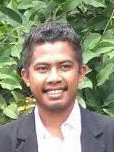 Deriatus Awa, a theology student of STT GKS Lewa told us that Sumba, known as the Sandelwood horse, cannot be separated from the savannah and weaving as the island's wealth. The Sumbanese are proud when the island becomes tourists’ destination, but they have not seen this as an opportunity. Through the training he admitted that his insight was open to know opportunities in tourism sector for a better economy in Sumba in the future.
Deriatus Awa, a theology student of STT GKS Lewa told us that Sumba, known as the Sandelwood horse, cannot be separated from the savannah and weaving as the island's wealth. The Sumbanese are proud when the island becomes tourists’ destination, but they have not seen this as an opportunity. Through the training he admitted that his insight was open to know opportunities in tourism sector for a better economy in Sumba in the future.Let's take a look at the available opportunities, take an option of businesses related to tourism and use social media optimally to promote Sumba, so that tourism in Sumba is growing and people's welfare is increasing. (JUF).




